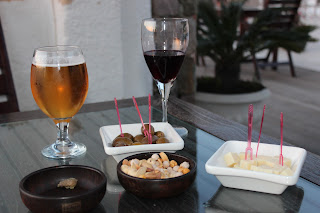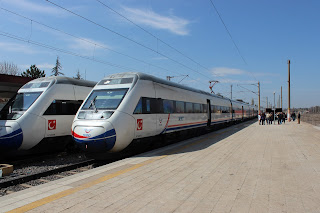Today is May 1, and it is Labor Day in Turkey, so no school and most businesses are closed. I have a little time this morning.
The settlement of Efesus was probably first inhabited about 1050 BC. One of the Seven Wonders of the Ancient World, the Temple of Artemis, was here. Efesus was first Greek, and at its peak around the 1st century BC, it was a part of the Roman Empire and had a population of 250,000. It was built on the banks of the Aegean Sea, but silt from the river Kaistros, filled in part of the port and the sea is now a couple of kilometers from the city.
The goddess Nike. Supposedly the swoosh came from a shoe executive visiting this carving, who decided to name his shoe company "Nike."
Our guide, Orhan, was a history major in college, and painted a very good picture of life in the 1st century as Romans in chariots rode and walked down the marbled streets. He asked us to try and picture this as we made our way down Curetes Street.
Columns all along the street
The Temple of Hadrian
The Terrace Houses, owned by the wealthy, had mosaic floors, and hot and cold running water!
At the end of Curetes Street was the Celus Library, one of the more complete walls of any building in Efsus. This was two stories high. The four female statues out front are replicas, as the original are in Austria. Many antiquities are missing in Turkey, as the person/group who first excavated a site, most often from Austria, Italy, or England, took treasures back to his/her homeland. Turkey is trying to get many of the historic items back, with limited success.
Because of its size, there were many bathhouses, latrines (with water running through troughs), and living quarters further off the main streets, but one or two were located in the main city area for use by soldiers, and the wealthy. Outside the city walls were bathhouses and latrines for travelers to use and clean up prior to entering the city.
Can you guess? A latrine on the main street.
Last on the tour, and closest to the sea, is the Grand Theatre. It was built and rebuilt with many additions, to its final capacity of 24,000. St. Paul preached here! The ruler of Efesus didn't like his ideas, and argued against St. Paul in the theatre as well.
Grand Theatre
Besides being a great historical place with Greek and Roman influence, to know that early Christians settled here is amazing. This is where many lived, with apostles and disciples residing here for a time, and where St. John wrote his gospel. With only 25% of the ruins uncovered, there are a lot of treasures yet to be found.
After Efesus, our tour was off to Pemukkale and Hierapolis.






















































